
* The Bo 105 proving successful, MBB collaborated with Kawasaki of Japan to build an enlarged follow-on, which emerged as the "BK-117". As with the Bo 105, the BK-117 proved popular, leading in turn to the refined Eurocopter "EC145", now Airbus "H145". The same design concepts led to the Indian HAL "Dhruv" helicopter and its "Prachand" gunship derivative, and so it is discussed here as a footnote -- along with the Kawasaki "OH-1 Ninja" scout helicopter.
* In the mid-1970s, MBB was working on what amounted to a scaled-up and improved derivative of the Bo 105, the "Bo 107". In the meantime, Kawasaki of Japan was working on a helicopter with similar specifications, the "KH-7". The two companies got in touch and decided to collaborate, resulting in an agreement in early 1977 to develop a common "MBB-Kawasaki BK 117".
Four prototypes were built, with the initial flight of a German prototype on 13 June 1979 and of a Japanese prototype on 10 August 1979. A pre-production machine, made in Germany, performed its initial flight on 6 March 1981, with the first production machine, made in Japan, performing its initial flight on 24 December 1981. International certifications followed in late 1982 and early 1983, with deliveries of the initial "BK 117A-1" variant from both partners quickly following.
A "BK 117A-3" model -- there was no production BK 117A-2 -- was introduced in 1985, featuring maximum take-off weight increased from 2,850 kilograms (6,285 pounds) to 3,200 kilograms (7,055 pounds), plus an updated tail rotor with greater diameter and twisted blades. Production then moved to the "BK 117A-4" in 1987, with minor improvements including a more robust power transmission, updated tail rotor head, and more fuel capacity.
* A general description of the BK 117 almost exactly matches that of the Bo 105. It had a conventional main-tail rotor configuration, with the main rotor system effectively borrowed from the Bo 105 but with larger blades (made of carbon composite instead of fiberglass), and a two-blade carbon composite tail rotor. The BK 117 had the same "pod and boom" configuration, with a somewhat more streamlined fuselage featuring skid landing gear and rear clamshell doors along with the side doors, plus twin swept fins on the tailboom. It was powered by twin engines, the powerplants being Avco Lycoming LTS 101-750B-1 turboshafts, each rated at 440 kW (590 SHP) for take-off.
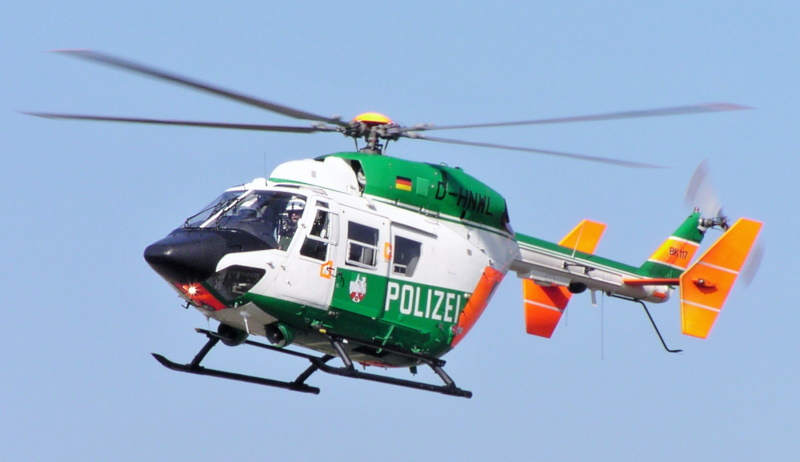
Like the Bo 105, few would have accused the BK 117 of being particularly sexy, though it had a certain clean utilitarian appearance. It was mostly made of aircraft aluminum, though it featured a few composite and titanium assemblies. Standard load was a pilot and seven passengers, with fewer passengers in executive versions. There was a forward-hinged door on either side of the cockpit and a rearward-sliding door on each side of the passenger compartment; the doors could be jettisoned in an emergency.
___________________________________________________________________
MBB-KAWASAKI BK 117A-4
___________________________________________________________________
main rotor diameter:
11 meters (36 feet 1 inch)
tail rotor diameter:
1.96 meters (6 feet 5 inches)
fuselage length:
9.91 meters (32 feet 6 inches)
footprint length:
13 meters (42 feet 8 inches)
height (tail rotor):
3.85 meters (12 feet 8 inches)
height (rotor head):
3.36 meters (11 feet)
empty weight:
1,705 kilograms (3,760 pounds)
max loaded weight:
3,200 kilograms (7,055 pounds)
maximum cruise speed:
255 KPH (160 MPH / 135 KT)
service ceiling:
4,575 meters (15,000 feet)
range:
585 kilometers (365 MI / 315 NMI)
___________________________________________________________________
Of course the BK 117 could be configured for air ambulance, SAR, cargo transport, and other duties. Optional kit included dual controls, a rescue winch, a belly cargo hook, weather radar in a nose pimple radome, searchlight, loudspeaker, inflatable flotation kit, skis, folding main rotor blades, and sand engine filters.
In 1985, MBB displayed a combat version of the BK 117A-3 designated the "BK 117A-3M" at the Paris Air Show. Kawasaki had nothing in particular to do with it: the Japanese constitution traditionally raised barriers to weapons export. The BK 117A-3M featured:
A wide range of alternate weapons fits was offered. There was polite interest, but nobody bought it.
In the late 1980s, MBB flew a BK 117 with a composite fuselage under a German government experimental program. In the early 1990s, Kawasaki also flew an advanced technology demonstrator, the "BK 117-P5", with a "fly by wire" flight control system. There were discussions with IPTN to assemble the BK 117 as the "NBK-117", but only three Indonesian machines were produced.
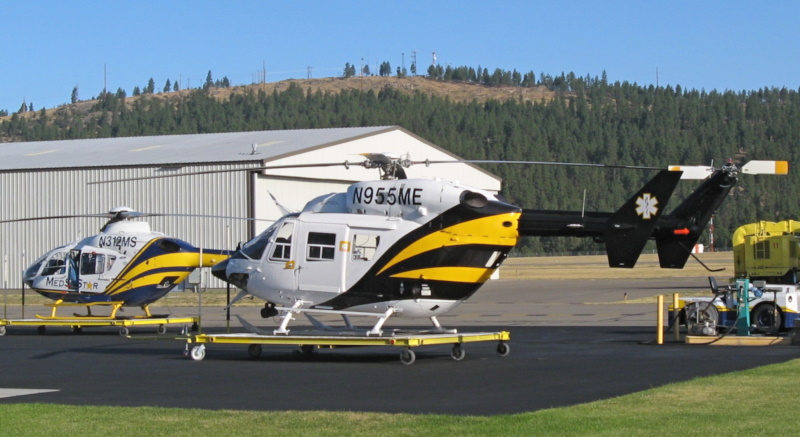
In 1987, production moved to the "BK 117B-1", with improved Avco Lycoming LTS 101-750B-1 engines and increased take-off weights compared to the A-series. The follow-on "BK 117B-2" raised take-off weight even more. The "BK 117C-1" series was introduced in 1992, featuring a modernized cockpit and twin Turbomeca Arriel IE turboshafts with 528 kW (708 SHP) each, replacing the Avco Lycoming powerplants.
BACK_TO_TOP* In 1997, work began on rethinking the BK 117 design, incorporating refinements derived from the EC135. Initial flight of the prototype was on 12 June 1999 in Germany, with a second prototype performing its initial flight in Japan on 15 March 2000; two more prototypes later joined the development program. Certifications of the "EC145", as the type was designated by Airbus, or the "BK 117C-2", as it was originally known and was designated in Japan, were in 2002, with production shipments beginning in that year.
The EC145 retained the general configuration of early members of the BK 117 family, except for a revised fuselage that provided substantially more internal volume, partly obtained by removing the cabin center post and door supports. It also featured a new main rotor derived from the EC135, with composite blades and a titanium hub, as well as a "glass cockpit" with flat-panel color displays.
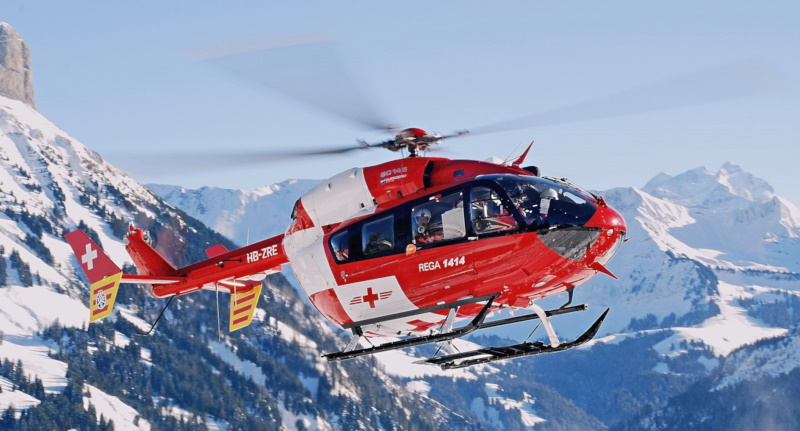
The EC145 scored a major win in mid-2006 when it was selected to fulfill the US Army's "Light Utility Helicopter (LUH)" requirement. The LUH program was focused on obtaining an off-the-shelf helicopter with minor military optimizations for non-combat roles, freeing up more expensive combat-fitted machines for frontline service. The EC145 was given the Army designation of "UH-72A Lakota", with initial deliveries in late 2006; Joe Red Cloud, a chief of the Lakota Indian nation, was a participant of the initial acceptance ceremony.
The US Army obtained 463 UH-72As to early 2021, with about two thirds of them going into service with the National Guard. Production was at an Airbus USA facility in Columbus, Mississippi. 187 of them were actually configured as dual-control trainers, the Army having decided to use the UH-72A to replace the Bell TH-67 Creek / Jetranger in the training role. The trainers were not redesignated "TH-72A", suggesting they are employed in utility roles as needed. The first trainer UH-72A was handed over in March 2015; some of the trainers were built new, while some were conversions.
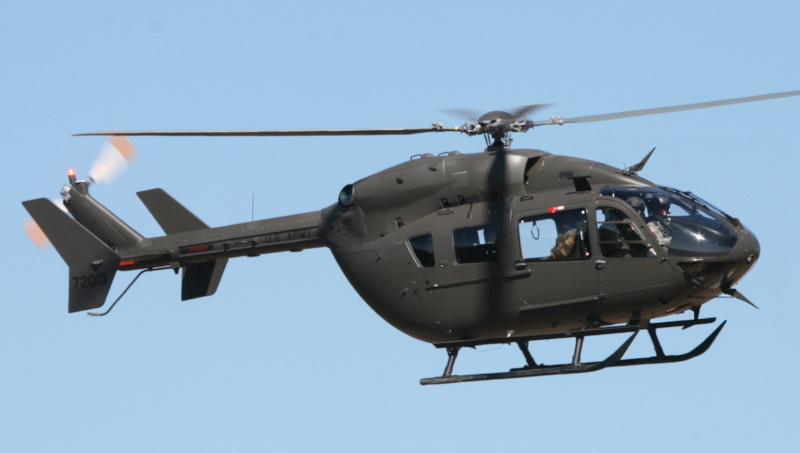
At least five of the UH-72As were assigned to the desert warfare training complex at Fort Irwin in California to support field wargames, playing as transport, scout, or gunship helicopters as needed -- kitted up with a "laser tag" system to perform, and receive, "attacks". They had additional kit to support range operations control, and were painted in desert camouflage colors. As of 2021, the US Army began receiving "UH-72B" machines, built to a modernized specification. It is unclear how many UH-72Bs will be obtained.
Airbus more or less revived the unsuccessful BK 117A-3M with a proposal for an armed derivative of the UH-72A for the US Army's "Armed Aerial Scout (AAS)" competition, with three "AAS-72X" demonstrators being built by Airbus in collaboration with Lockheed Martin. The first flew in 2010. Illustrations of the machine showed it to have an imaging / targeting turret under the nose, plus a stores rack on each side, each rack capable of handing two Hellfire anti-armor missiles, or two 70-millimeter rocket pods, or a rocket pod and a gun pod.
The AAS competition was suspended, with the Army moving on to evolved plans for an armed scout. Airbus also offered a similar "EC645" for other military requirements, with options for twin stores pylons, an electro-optic targeting system, and helmet-mounted sight. In addition, the firm worked with the French Army on an "optionally piloted" configuration of the EC145 for robotic resupply, initial test flights taking place in the spring of 2013. So far, however, Airbus hasn't offered a drone version of the type.
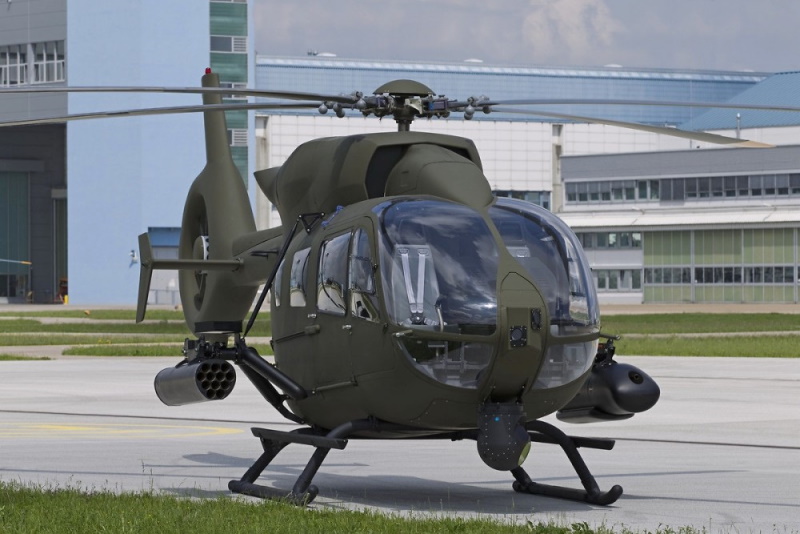
In 2011, Airbus announced the "EC145 T2" -- now "H145" -- with uprated Arriel 2E engines and drivetrain, fenestron tail rotor, updated avionics, and other new features. Initial deliveries were in mid-2014. It appears the US Army UH-72B is based on this variant. The firm also introduced a militarized version, the "H145M" -- previously "EC645 T2" -- on offer, with initial deliveries in 2015 to German Kommando Spezial-Kraefte (KSK) special-operations forces. It has since been sold to other countries, including Hungary, Lithuania, Luxembourg, and Serbia.
Airbus developed an armed combat kit for the H145M, called the "HForce Generic Weapon System (GWS)", available as an option or for retrofit. It provided a mission computer, a Thales Scorpion helmet-mounted sight, an electro-optic turret, gunner firing kit, and weapons options including machine gun / cannon pods, unguided rocket pods, and various air-to-surface or air-to-air guided missiles. Hungary obtained the HForce GWS as an upgrade to their H145Ms, while Germany ordered 62 H145Ms with GWS in late 2023 -- 57 to army, 5 to air force -- with an option for 20 more later.
BACK_TO_TOP* The MBB family of helicopters includes an Indian relative. In 1984, Hindustan Aerospace Limited (HAL) of India signed a contract with MBB for development of what was then designated the "Advanced Light Helicopter (ALH)", leading to rollout of a nonflying test airframe in the spring of 1991, and initial flight of the first of five flying prototypes on 30 August 1992. The five prototypes included two engineering validation prototypes, plus one prototype each of army-air force, navy, and civil versions. The production machine was to be given the name of "Dhruv (Polaris / Pole Star)". Deliveries were delayed because of US objections to Indian nuclear tests that blocked delivery of LHTEC CTS800 turboshaft engines, but production machines were finally delivered to the Indian Army in 2002, with deliveries following to other users.
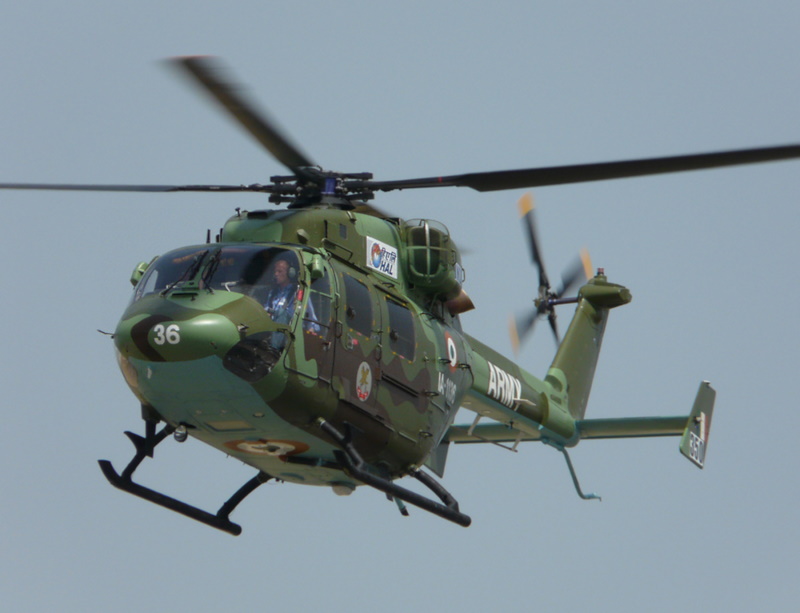
The resemblance of an army-air force Dhruv to the BK 117 was unmistakeable, though the Dhruv was a bigger machine, with an empty weight about 50% greater than that of the BK 117. Otherwise, the two rotorcraft were very similar, with the Dhruv featuring a pod-&-boom / main-tail rotor configuration, clamshell rear doors, skid landing gear, twin swept tailfins, and a four-blade main rotor. It did noticeably differ from the BK 117 in featuring a four-bladed tail rotor.
As introduced, the Dhruv was powered by twin Turbomeca TM333-2B turboshafts, each rated at 788 kW (1,057 SHP) -- though the longer-term goal was to fit locally-built Ardiden 1H / Shakti turboshaft, built by HAL with Turbomeca assistance, providing 895 kW (1,200 SHP) each for enhanced "hot & high" operation -- an important consideration for the Indian Army and Air Force, since operations are often conducted in the mountainous northern regions of the country. Composite materials made up a large proportion of the rotorcraft's structure. Fuel tanks were bullet-resistant, crashworthy, and self-sealing.
Early Dhruv production had a "steam gauge" instrument layout, but it was soon updated to a "glass cockpit" configuration. Two flight crew were normal, with 12 seats for passengers or 14 seats in a high-density configuration. In the medical role, the Dhruv could fit four stretchers and two medical attendants. Along with the clamshell rear doors, there was a hinged cockpit door and sliding passenger door on each side.
___________________________________________________________________
HAL DHRUV (ARMY-AIR FORCE VARIANT):
___________________________________________________________________
main rotor diameter:
13.2 meters (43 feet 4 inches)
tail rotor diameter:
2.55 meters (8 feet 4 inches)
fuselage length:
13.43 meters (44 feet 1 inch)
footprint length:
15.87 meters (52 feet 1 inch)
height (tail rotor):
4.98 meters (16 feet 4 inches)
height (rotor head):
3.93 meters (12 feet 11 inches)
empty weight:
2,550 kilograms (5,622 pounds)
max loaded weight:
4,500 kilograms (9,920 pounds)
maximum cruise speed:
265 KPH (165 MPH / 145 KT)
service ceiling:
6,500 meters (21,320 feet)
range, 10 passengers:
220 kilometers (135 MI / 120 NMI)
___________________________________________________________________
The Dhruv could be armed with a light machine gun on a pintle in one or both doors; a defensive countermeasures system could be fitted as well. HAL offers an armed version, the "Rudra", featuring a sensor turret on top of the nose; an undernose turret carrying a 20-millimeter cannon; and stores pylons for unguided rockets pods, anti-armor missiles, or air-to-air missiles.
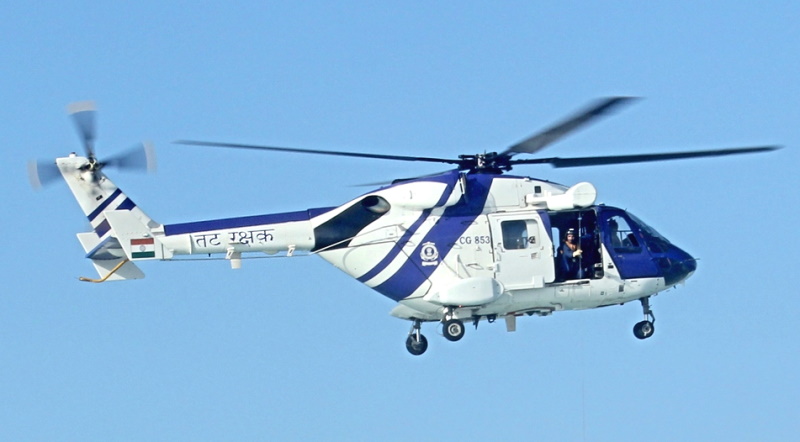
The original "Dhruv Mk.1" featured the Turbomeca engines and steam-gauge cockpit, with 56 delivered to the Indian military. It was followed by the "Dhruv Mk.2" featuring the glass cockpit, with 20 built -- to be quickly followed in turn by the "Dhruv Mk.3" with the Shakti-1H engines, plus a defensive countermeasures suite. The "Mk.4" is the armed Rudra, originally called the "Dhruv Weapon Systems Integrated (WSI)".
The naval / coast guard version was based on the Mk.3. It differed from the army-air force version in having wheeled retractable tricycle landing gear -- skid landing gear is inconvenient for shipboard operations -- with the main gear assemblies retracting into sponsons. The naval version also included a deck harpoon capture fixture; a sonar system; a stores attachment on each side of the fuselage for a torpedo or other munition; a 12.7-millimeter machine gun on a flexible mount; a nose radar; and a roof-mounted infrared imager an option. The coast guard version lacked the sensors and stores attachments, but retained the 12.7-millimeter machine gun; it added a searchlight and a loud-hailer. HAL has worked with Israeli Aircraft Industries (IAI) to develop a drone version of the naval Dhruv, the status of that exercise is unclear.
The civil version used the Turbomeca engine, differing from the military version in having hinged passenger doors. It was available with retractable wheeled landing gear, the rear wheels tucking into sponsons; fixed wheeled landing gear; or skid landing gear -- these variants being designated "C", "CFW", or "CS" respectively. Civil Dhruves have been exported to Ecuador, Mauritius, Maldives, and Nepal. HAL has worked with IAI on a military export version of the Dhruv, with a full "glass cockpit", a sensor system, a defensive countermeasures system, and an expanded range of offensive stores.
* The Dhruv was the basis for a helicopter gunship, the "Light Combat Helicopter (LCH)". It was no more or less than a Dhruv Mk.3 with the normal forward fuselage replaced by a stepped tandem seat fuselage. Initial flight of the first prototype of the "Prachand" -- meaning "Giant" or "Intense" -- was on 29 March 2010. Development was protracted, with the first LCHs delivered in 2022.
The Prachand was armed with undernose 20-millimeter cannon turret, day-night sight on top of the nose, and stores stub wings, with a total of four stores attachments. Possible stores included 12-round rocket pods for 70-millimeter unguided or laser-guided missiles, packs with two Mistral anti-air missiles each, a range of anti-armor missiles, and guided or gravity bombs with sizes of up to 250 kilograms (550 pounds).
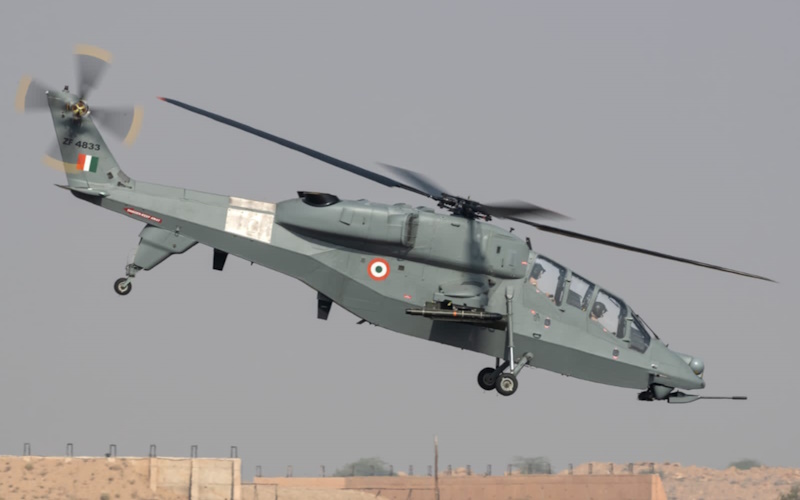
Overall dimensions -- length, rotor diameter, & height -- were the same as for the Dhruv, as was the empty weight, and performance was similar to that of the Dhruv Mk.3, the Prachand having the same Shakti-1H engines. Loaded weight was heavier, at 5,800 kilograms (12,785 pounds), and range was greater, at 550 kilometers (340 miles, 300 NMI), with a combat load. At last notice, the Indian Air Force and the Indian Army wanted to obtain 76 and 95 respectively, for a total of 171. There has been some interest in export sales.
* As a footnote to the MBB helicopters story ... Kawasaki Heavy Industries, as a rule, focused on license-built production of foreign designs including the Boeing Sea Knight and Chinook, the Hughes H-6, and the Leonardo AW101. Collaborating with MBB on the new-design BK117 was an exception to the rule -- as was the "OH-1 Ninja", a tandem-seat scout helicopter, and the only helicopter designed solely by Kawasaki that went into production.
The Japanese Ground Self-Defense Forces (JGSDF) began to look for a replacement for its Kawasaki-built Hughes OH-6D scout helicopters, with a requirement for the "OH-X" issued in 1989. Kawasaki was selected as the winner in 1991, with the first of four "XOH-1" flight prototypes taking to the air on 6 August 1996, the last being delivered for test a year later. Two static-test airframes were built as well. Initial delivery of a production "OH-1" to the JGSDF was in 2000. It was nicknamed the "Ninja".
As introduced, the OH-1 had a configuration like that of a typical helicopter gunship, having a sharklike fuselage, stub wings with a total of four stores attachments, and a tandem cockpit -- pilot in front, observer in back on a raised seat. The only unusual feature at first notice was a fenestron "fan in tail" instead of a tail rotor, the fan having eight blades.
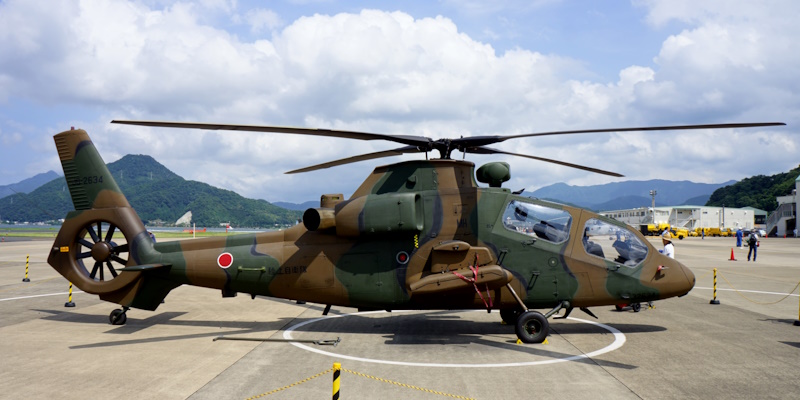
The OH-1 featured extensive use of composite materials in its construction, and had fixed landing gear in tailwheel configuration. It was powered by twin Mitsubishi TS1-10QT turboshafts with full authority digital engine controls (FADEC) and 660 kW (890 SHP) each, driving a four-blade composite rotor. The OH-1 had an automatic flight control system (AFCS) with stability augmentation. The crew sat on armored seats, with two flat-panel displays for each crewperson, and a head-up display (HUD) for the pilot in front. Both crew had "hands on collective & stick (HOCAS)" controls; they got in and out through upward-hinged cockpit transparencies on the right.
___________________________________________________________________
KAWASAKI OH-1 NINJA:
___________________________________________________________________
main rotor diameter:
11.6 meters (38 feet 1 inch)
fuselage length:
12 meters (39 feet 4 inches)
height:
3.8 meters (11 feet)
empty weight:
2,450 kilograms (5,400 pounds)
max loaded weight:
4,000 kilograms (8,820 pounds)
maximum speed:
280 KPH (175 MPH / 150 KT)
cruise speed:
220 KPH (140 MPH / 120 KT)
service ceiling:
4,880 meters (16,010 feet)
range:
550 kilometers (340 MI / 300 NMI)
___________________________________________________________________
There was a sensor turret just forward of the rotor pedestal, with an infrared imager, an optical camera, and laser rangefinder / target designator. There was also an infrared "disco light" jammer behind the pedestal to throw off heat-seeking missiles. A wide range of stores could, in principle, be carried on the four stores pylons, but it appears that the only ones that were included a 235-liter (62 US gallon) external fuel tank on each inboard pylon, and a pack of two Type 91 anti-air missiles on each outboard pylon. The Type 91 was a follow-on design to the US Stinger.
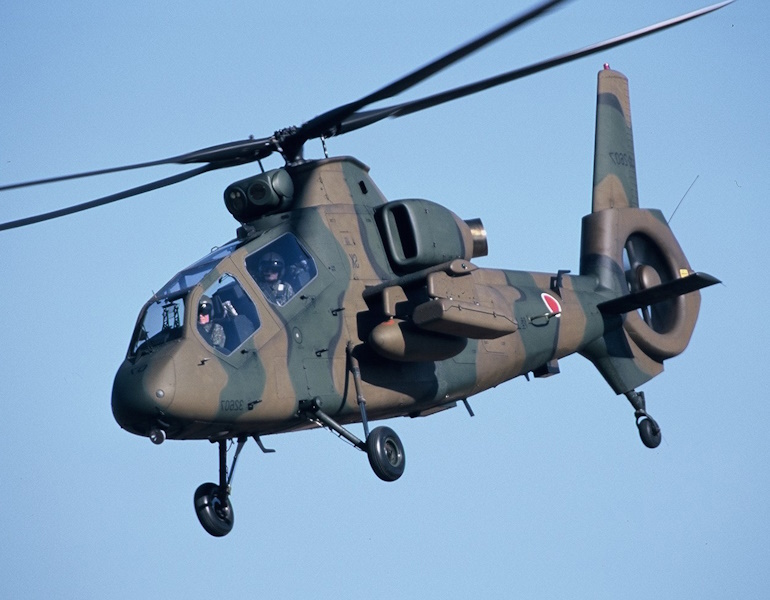
Only 38 OH-1s were built to 2014, including the four prototypes, which were brought up to production standard and fielded. Thanks to budget cuts, the OH-6D continued to soldier on. There was talk of a utility version, with a new fuselage, and an attack gunship version, but they didn't happen. In 2022, the decision was made to retire the JGSDF's crewed scout and attack helicopters in favor of drones, so the OH-1 will be phased out of service.
BACK_TO_TOP* The primary sources for this document were a set of JANE'S ALL THE WORLD'S AIRCRAFT from my local library. Miscellaneous items were also obtained off the internet, particularly write-ups from "aerospace-technology.com". Gorka Martinez, a fine source on things that fly over Spain, was kindly enough to field some questions on the Spanish Bo 105s on request.
I was actually intrigued to see both Bo 105s and BK 117s operating in the colors of a medical service in my original hometown of Spokane, Washington. There was a time when it was unusual to see foreign-built flying machines in the USA, but it is much less unusual than it was. Incidentally, the Red Bull brewing company, which has pumped a fair amount of money into flashy airshow flight demonstrations, operates a Bo 105 -- maybe more than one -- in airshow aerobatic demonstrations. I managed to finally see it in action at Marine Corps Air Station Miramar in California in 2012.
* This document was put together from air encyclopedias, my collection of JANE'S ALL THE WORLD'S AIRCRAFT, and informal sources such as Wikipedia. These machines are not very well documented.
Illustrations credits include:
* Revision history:
v1.0.0 / 01 jul 09 v1.0.1 / 01 apr 10 / Review & polish. v1.0.2 / 01 mar 12 / Review & polish. v1.0.3 / 01 feb 14 / Eurocopter became Airbus Helicopter. v1.0.4 / 01 jan 16 / Antitank Bo105s retired. v2.0.0 / 01 dec 17 / Broke into two chapters for ease of maintenance. v2.0.1 / 01 dec 19 / Review, update, & polish. v2.0.2 / 01 oct 21 / Review, update, & polish. v3.0.0 / 01 mar 24 / Added Kawasaki OH-1, more on Dhruve. (+)BACK_TO_TOP
